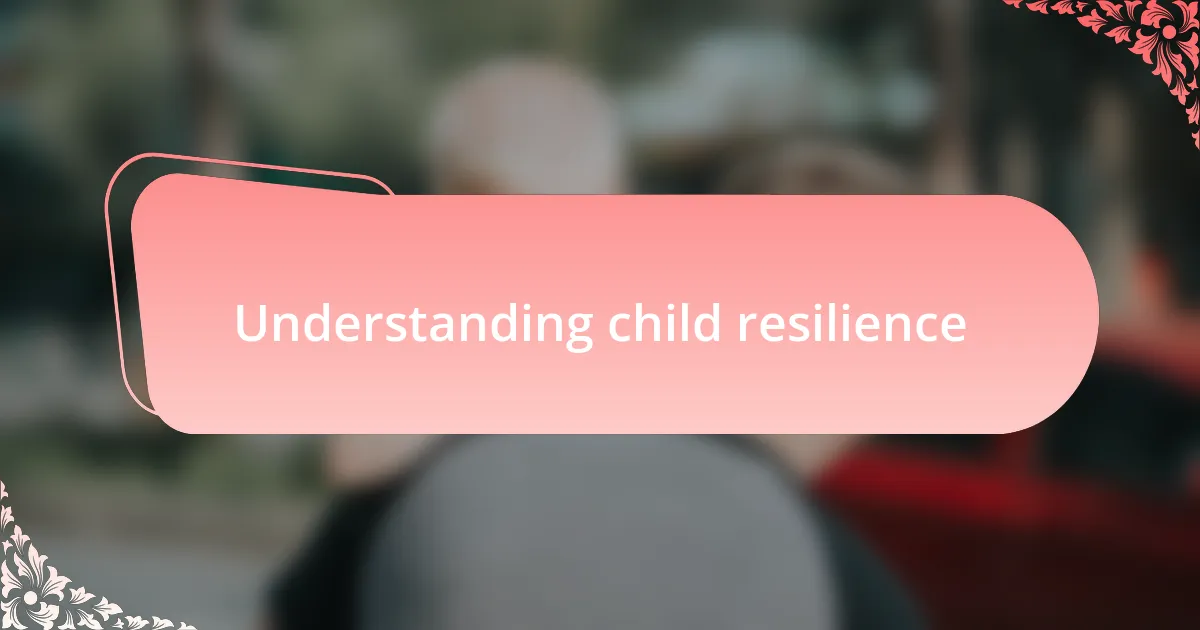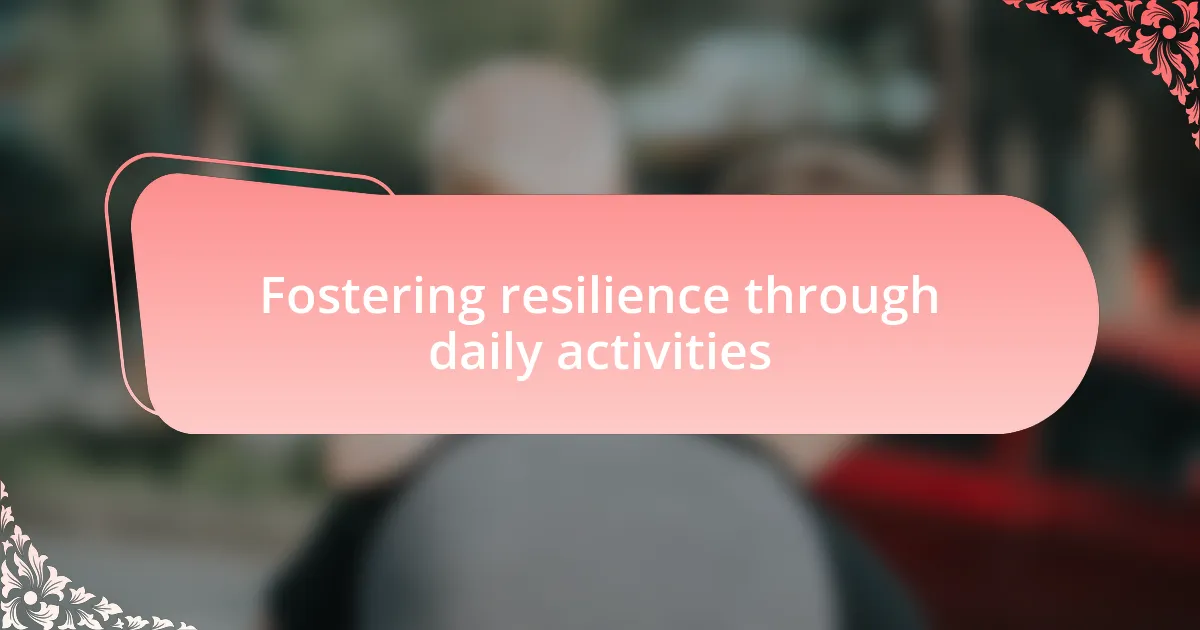Key takeaways:
- Resilience helps children navigate challenges and develop problem-solving skills, fostering emotional growth.
- Encouraging open communication, celebrating small victories, and modeling emotional expression are essential for building resilience.
- Daily activities and creative outlets serve as practical opportunities to teach resilience and coping strategies.

Understanding child resilience
Understanding child resilience is crucial in fostering a supportive environment for growing minds. Resilience refers to the ability to bounce back from challenges and adversity. Think about a time when your child faced a setback—perhaps they didn’t ace a test or felt excluded from a playdate. How did they respond? The way children navigate these experiences can shape their emotional and psychological growth.
As I’ve observed in my interactions with different children, the responses to failure and stress often vary widely. Some children may quietly withdraw, while others might approach the situation with curiosity, asking questions about how to improve. I’ve seen firsthand how a simple conversation about persistence can ignite a spark of determination in a child. Reflecting on my own childhood, I remember feeling immensely proud when I finally learned to ride a bike after numerous falls. That sense of achievement was rooted in resilience, a trait we can encourage in our kids through our support.
Building resilience isn’t just about teaching kids to endure hardships; it’s about nurturing their ability to express themselves and seek help when needed. Have you noticed how children often mirror adult attitudes? If they see us handling stress with grace, they’re more likely to adopt similar coping strategies. In my experience, celebrating small victories and encouraging problem-solving can significantly impact their ability to manage future challenges effectively. How are you helping your child pave their path to resilience?

Importance of resilience in children
Resilience plays a vital role in a child’s development, acting as a protective factor against life’s inevitable challenges. I remember a time when my niece faced disappointment after not making the team she tried out for. Instead of giving up, she channeled her feelings into practice, eventually not just making the team the following year but also developing a love for the sport. This ability to turn setbacks into stepping stones is what builds a strong foundation for their emotional health.
Moreover, resilient children often exhibit better social skills and problem-solving abilities. In my own experience, I’ve seen children who cope well with difficulties naturally help their peers in tough situations. When they trust in their ability to overcome obstacles, they’re more likely to offer support to others, creating a nurturing circle among peers. Isn’t it gratifying to see how cultivating resilience can lead to a more compassionate environment?
Ultimately, children with resilience tend to approach life with a hopeful outlook. When my son faced a tough academic challenge, we took the time to discuss his feelings and brainstorm strategies together. Watching him tackle the problem not only boosted his confidence but also reinforced a positive mindset—one that sees challenges as opportunities for growth. How do you view your child’s struggles? By shifting perspective, we can see them as integral to developing resilience.

Strategies to promote emotional health
To promote emotional health in children, creating a safe space for expression is essential. I recall a parent workshop I attended where we discussed the importance of active listening. I realized that sometimes, simply allowing my child to share their thoughts without interruption led to breakthroughs in understanding their emotions. Have you ever noticed how empowering it feels when children know their feelings are validated?
Encouraging healthy outlets for emotions is another strategy that has proven effective. I once introduced my daughter to journaling; it became a ritual for her to reflect on her day and express her feelings. Witnessing her transform her raw emotions into creative writing was nothing short of inspiring. Have you thought about how simple activities like drawing or playing music can also serve the same purpose?
Lastly, teaching mindfulness practices can significantly enhance emotional health. Introducing my son to activities like deep breathing exercises and meditation opened a new world for him. His reaction was astonishing; he became more centered and better equipped to handle stress. When was the last time you explored mindfulness with your child? I genuinely believe that instilling these practices cultivates a lifelong skill set for emotional resilience.

Building a supportive environment
Creating a supportive environment starts with fostering open communication. I remember one evening when my son shared a trivial frustration about his day at school. Instead of brushing it off, I took the time to sit beside him and asked open-ended questions about his feelings. That simple act made him feel heard and valued, reinforcing the importance of dialogue in our relationship. Have you ever noticed how a few minutes of genuine conversation can transform a child’s day?
It’s also vital to establish routines that promote stability and predictability. I find that setting a consistent family dinner time not only encourages good nutrition but also becomes a moment for everyone to connect. During these meals, we share highs and lows of the day, creating a tradition that strengthens our family bonds. How might your own family’s routines support emotional resilience?
Lastly, the role of physical space cannot be overlooked. Designing a cozy corner in our home filled with books and art supplies has become a haven for creativity and expression. This space invites my children to unwind and explore their feelings without any pressure. Have you considered how your physical environment can reflect support and comfort for your child? The little touches can create a nurturing atmosphere that encourages resilience.

Encouraging positive coping skills
One of the most effective ways I’ve found to encourage positive coping skills in my children is through modeling emotional expression. Last week, after a particularly challenging day, I openly talked about my feelings of frustration and sadness at the dinner table. It sparked a candid discussion, allowing my kids to share their own emotions and realize that it’s completely okay to feel overwhelmed sometimes. Have you ever tried sharing your own struggles to encourage your child to do the same?
I also emphasize creative outlets as a way to process emotions. When my daughter felt anxious before a big presentation, I suggested we create a vision board together. We filled it with bright images and affirmations that reflected her dreams. Watching her confidence grow as she engaged in this creative process made me appreciate the power of self-expression. How do you provide healthy channels for your child to explore their feelings?
Another technique that has worked well in our home is positive reinforcement for coping strategies. I instituted a “celebration jar,” where we could drop notes for each time someone practiced a positive coping skill — like deep breathing or journaling. When the jar filled up, we celebrated together. This not only recognizes their efforts but also inspires them to continue using these techniques. Have you considered how small rewards can reinforce positive behaviors in a meaningful way?

Fostering resilience through daily activities
Daily activities can serve as a natural backdrop for fostering resilience in children. I recall a rainy afternoon when I joined my kids to tackle a challenging puzzle together. It was more than just a game; it became an opportunity to discuss patience, teamwork, and the beauty of perseverance. Have you ever noticed how collaborative tasks can reveal a child’s ability to navigate frustration and success?
In my experience, incorporating routine chores can also build resilience. When my son helps me in the garden, he learns not just about planting and nurturing but also about facing challenges like pests or poor weather. Each setback is a lesson in resilience, and we celebrate the little victories together, reinforcing the idea that effort leads to growth. How often do you turn regular chores into opportunities for life lessons?
Another daily ritual I find valuable is family story time, where we share stories about characters overcoming obstacles. One evening, after reading a tale of a brave princess, my daughter remarked how much she admired the character’s courage. This sparked a conversation about courage in our lives, leading her to share her own fears and triumphs. Have you considered how stories can inspire children to connect their experiences with resilience in a relatable way?